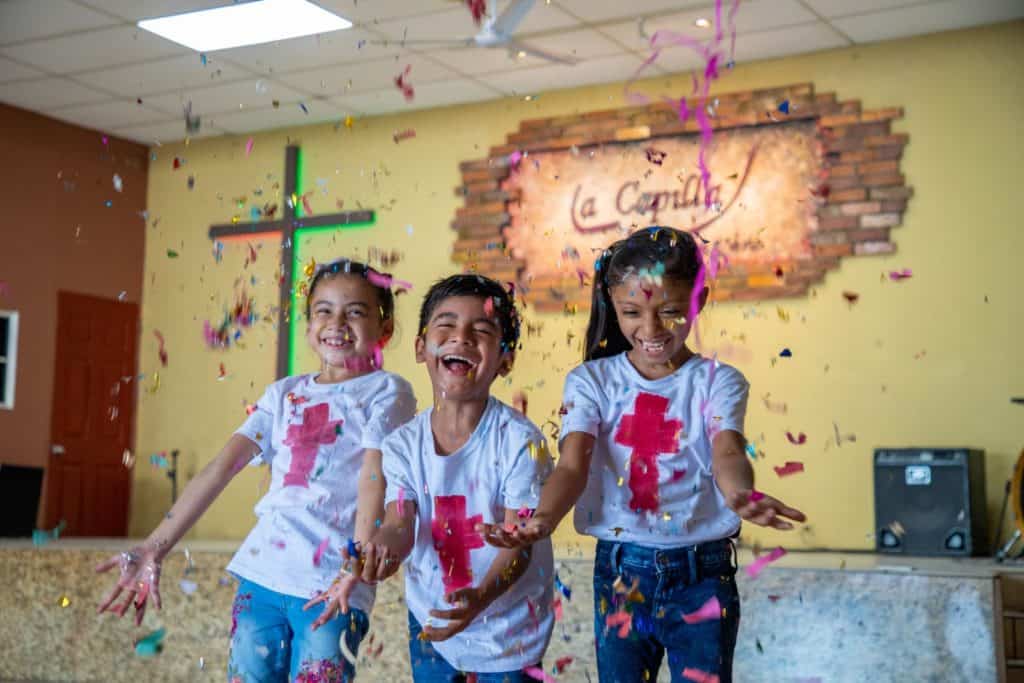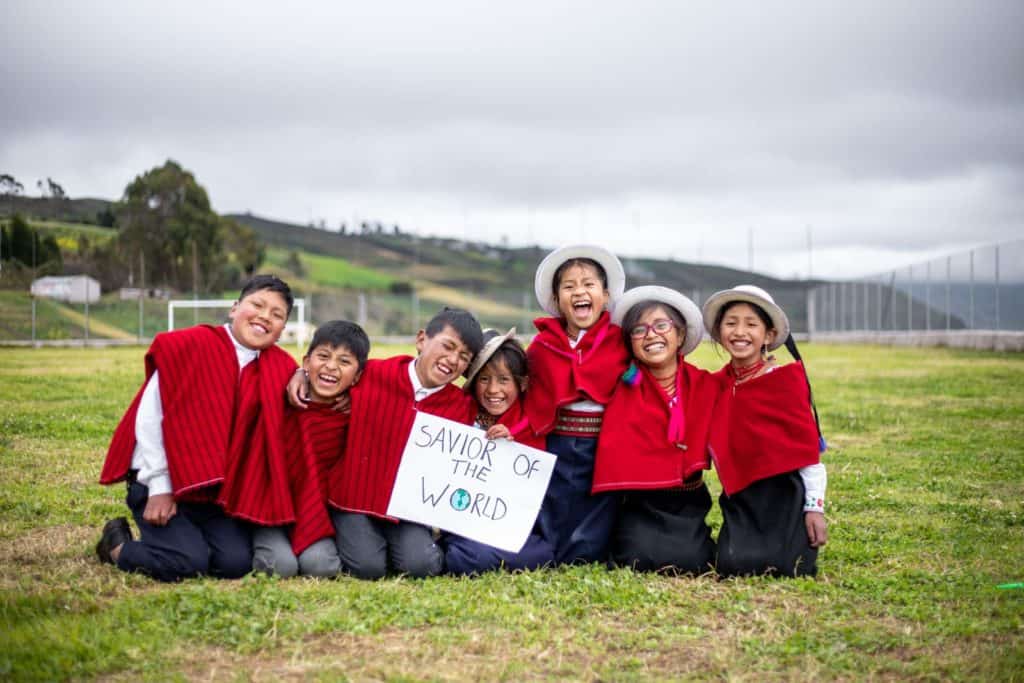
What is Easter About?
Easter is a Christian holiday that celebrates the resurrection of Jesus Christ from the dead. Christians believe that Jesus is both God and human. When we celebrate Easter, we give thanks that Jesus died on the cross for the forgiveness of sins, taking the punishment that we deserve and also defeating sin, Satan and death.
Christians believe that after he died and the body of the Lord Jesus was buried in a tomb, on the third day Jesus rose from the dead and is still alive. The true meaning of Easter is found in Scriptures like John 3:16: “For God so loved the world that he gave his one and only Son, that whoever believes in him shall not perish but have eternal life” (NIV).
The resurrection of the Lord Jesus is the most important story in the Christian faith. It tells us the price God paid for the forgiveness of our sins and how God makes a way for us to have eternal life.
Where is the Easter Story Found in the Bible?
What chapter? What book?
You can find the story of Easter in the New Testament section of the Bible. Each Gospel tells the full story: Matthew 26-28, Mark 14-16, Luke 22-24 and John 12-20. These Bible verses focus on different details, but they agree about the important major events that happened:
- Jesus and his disciples went to Jerusalem for the Passover feast.
- Jesus was very popular with the Jewish people because of his signs, miracles and teaching about the kingdom of God. Many people were gathered in Jerusalem because of the Festival of Unleavened Bread and the Passover feast, and Jesus received a lot of attention.
“When Jesus entered Jerusalem, the whole city was stirred and asked, “Who is this?”
Matthew 21:10-11
The crowds answered, “This is Jesus, the prophet from Nazareth in Galilee.”
- Smaller groups of Jews, especially the leaders called the Pharisees, were jealous of Jesus and also angry that he was claiming to be God in human form.
- The Roman authorities did not like Jesus because they were afraid he would lead the Jewish people to rebel against them.
- One of Jesus’ disciples, Judas, betrayed him to the Jewish leaders and the Roman government officials.
- After Jesus and his disciples ate the Passover meal together, Jesus was arrested and taken to see the chief priests. The priests were furious that Jesus claimed to be the Son of God, which meant he was claiming to be one with God. They decided to give Jesus to the Romans to be killed by them.
- The Romans beat Jesus and made fun of him while he was in custody. The Roman leader, Pontius Pilate, held a trial for Jesus and found him innocent, but in order to please the Jews who were angry at Jesus he sentenced Jesus to die by crucifixion. (Crucifixion is one of the cruelest forms of historical capital punishment. Victims of crucifixion were nailed in their hands and feet to a wooden cross. It was a way for the Romans to torture and humiliate rebels who challenged their authority in Israel and other colonies).
- Jesus carried the cross to a place called Golgotha (“the Place of the Skull”) outside the city and was nailed to the cross. This happened in the morning hours on the Friday after Passover.
- During the time of crucifixion, many miraculous signs took place. Eventually, Jesus cried out in a loud voice to God and died.
- Jesus’ body was buried in a tomb on that same day before the Sabbath began.
- On the third day after the death of Christ, and the first day of the week, some of his followers, including Mary Magdalene and Peter, came to the tomb and found the stone rolled away because the resurrection of Jesus Christ had taken place, just as he had foretold before his death.
In 1 Corinthians 15, the story is summed up this way:
“For what I received I passed on to you as of first importance: that Christ died for our sins according to the Scriptures, that he was buried, that he was raised on the third day according to the Scriptures, and that he appeared to Peter, and then to the Twelve. After that, he appeared to more than five hundred of the brothers and sisters at the same time, most of whom are still living, though some have fallen asleep.”
1 Corinthians 15:3-6 (NIV)
When is Easter Celebrated?

The date of Easter Sunday changes every year. It is related to the timing of the Jewish holiday Passover, the spring equinox and the cycles of the moon. Also, different Christian denominations and cultures calculate the timing differently. This type of holiday is known as a “moveable feast” because it is not celebrated the same day each year, unlike Christmas or Valentine’s Day.
Many countries also celebrate the days surrounding Easter as holidays, such as Good Friday and Easter Monday. Traditionally, the week leading up to Easter is known as Holy Week, with special church traditions to mark the events of the Easter story. Some traditions observe the period of Lent, a time of repentance and special fasting for the 47 days before Easter. Other Christian traditions just gather to celebrate the death and resurrection of Christ on Easter Sunday. In 2022, many Christians will celebrate Easter on Sunday, April 17.
What Does the Word “Easter” Mean?
The word “Easter” is related to the season of spring and the change in weather that happens in the northern half of the world. In March and April, the plants that are resting for winter begin to come back to life.
Before Christianity came to Europe, pagan Anglo-Saxons in England celebrated spring with a feast for a false goddess named Eostre. When the English people converted to Christianity, they changed the celebration to a celebration of Christ and his resurrection but kept the old name. Some people prefer to call Easter “Resurrection Sunday” instead.
What Easter Traditions do Children Around the World Have?
In countries that are more secular, such as the United States, children have Easter egg hunts and hear stories about the Easter Bunny. These traditions are not really related to the story of Jesus and his resurrection. They are more about celebrating the coming of spring. The egg can be a symbol of newness of life for Christians.
In many parts of the world, there are parades during Holy Week that act out the suffering and death of Jesus that the Gospels depict in Matthew 27, Mark 15, Luke 23 and John 19.
Children in Compassion’s program around the world enjoy Easter celebrations organized by their local churches. For churches, it is a chance to share the good news of Jesus with participants. Here are some fun traditions for Compassion participants:
- In El Salvador, churches host Easter camps for youths and children during Holy Week. At camp, children learn about the love of Jesus, and many accept Jesus as their Savior. They end the week with a Sunday resurrection service and Bible school for children.

- In Indonesia, children participate in a “torch relay.” They get up before dawn on Easter morning and march with homemade torches, singing songs about Jesus and his resurrection. They color and paint eggs and read the Bible story of Easter together.

- In Rwanda, children act out the Easter drama at church with a play about the death of Jesus Christ on the cross and his resurrection. They also eat a special meal with rice (and meat if their family can afford it). Families who have television sets enjoy watching Easter movies together.

- In Ecuador, many cities follow the tradition of having a funeral parade for Jesus, where everyone wears black. Some children find this tradition scary. Compassion partner churches like to share the story behind the parade and focus on hope and love. Children gather to hear the story of Jesus’ death and ask questions about it. They celebrate at the end of the story when Jesus conquers death. The resurrection service includes dancing and singing.

Easter is a time when churches unite and remember the love of Jesus. We all give thanks for salvation and new life! Celebrating Jesus’ sacrifice and resurrection brings us together. How do you plan to celebrate Easter this year?
See how Easter is celebrated in each of the 25 countries where Compassion-assisted children live!
What Bible Verses Help Me Understand the Meaning of Easter?
At Easter, we remember that Christ died for our sins:
But God demonstrates His own love toward us, in that while we were still sinners, Christ died for us. Much more then, having now been justified by His blood, we shall be saved from wrath through Him. (Romans 5:8-9, NKJV)
At Easter, we remember that Christ’s resurrection gives us new life:
Jesus said to her, “I am the resurrection and the life. The one who believes in me will live, even though they die.” (John 11:25, NIV)
Since, then, you have been raised with Christ, set your hearts on things above, where Christ is, seated at the right hand of God. (Colossians 3:1, NIV)
At Easter, we remember that God’s kingdom is here. God will have the victory:
We give thanks to you, Lord God Almighty,
the One who is and who was,
because you have taken your great power
and have begun to reign. (Revelation 11:17, NIV)
More Easter Bible Verses
From the New International Version:
He is not here; he has risen! Remember how he told you, while he was still with you in Galilee: “The Son of Man must be delivered over to the hands of sinners, be crucified and on the third day be raised again.” (Luke 24:6-7)
Brothers and sisters, we do not want you to be uninformed about those who sleep in death, so that you do not grieve like the rest of mankind, who have no hope. For we believe that Jesus died and rose again, and so we believe that God will bring with Jesus those who have fallen asleep in him. (1 Thessalonians 4:13-14)
In him we have redemption through his blood, the forgiveness of sins, in accordance with the riches of God’s grace. (Ephesians 1:7)
From the New King James Version:
For the love of Christ compels us, because we judge thus: that if One died for all, then all died; and He died for all, that those who live should live no longer for themselves, but for Him who died for them and rose again. (2 Corinthians 5:14-15)
And being found in appearance as a man, He humbled Himself and became obedient to the point of death, even the death of the cross. Therefore God also has highly exalted Him and given Him the name which is above every name, that at the name of Jesus every knee should bow, of those in heaven, and of those on earth, and of those under the earth, and that every tongue should confess that Jesus Christ is Lord, to the glory of God the Father. (Philippians 2:8-11)
Therefore we also, since we are surrounded by so great a cloud of witnesses, let us lay aside every weight, and the sin which so easily ensnares us, and let us run with endurance the race that is set before us, looking unto Jesus, the author and finisher of our faith, who for the joy that was set before Him endured the cross, despising the shame, and has sat down at the right hand of the throne of God. (Hebrews 12:1-2)
Easter’s Meaning to Children in Poverty
The message of Easter brings hope to all. And children living in poverty are in desperate need of hope. When children in our program learn the meaning of Easter at their Compassion centers, it brings them great joy.
Abigail, a 7-year-old in Compassion’s program in Ecuador, explains Easter in this way: “We celebrate that Jesus is more powerful than everything. Jesus is more powerful than death.”
Because our Child Sponsorship Program is holistic, we address the economic, socio-emotional, physical and spiritual needs of children living in poverty. We are a Christ-centered, church-driven and child-focused ministry. From Haiti to Indonesia, our frontline church partners around the world teach that God loves each child and that each child was created with a divine purpose.
Sponsor a child today and share the meaning of Easter.
Photos by Vera Aurima, Nico Benalcazar, Galia Oropeza, Doreen Umutesi and Alejandra Zuniga.







3 Comments |Add a comment
Abigail
Birthday: August 05, 2005
In wish to write my adopted child as Identified above. and efforts to write he a letter comes up pre-written.
I have been recently hospitalized and lost my letter writing skills.
All my attempts at writing her come up with letters already prewritten.
I wish to know how she is faring in COVID Ridden Ghana
Please help
Grand-Dad Ken
Hi, Ken! Thank you so much for reaching out to us about writing letters to Abigail. We would be happy to provide some tips as well as look and see what information we can find on her wellbeing. Would you kindly send us an email to [email protected]?
Hi Strachan !
How grateful all children of Lord God are while they have etenal hope whatever their situation are !
Your message is so well declared about what Jeuse Christ said and the Spirit of God has been testified thru followers of Jesus. Every passage you wrote are empowing to whoever admires the Spirit of God and fear of the Heavenly Father.
Really appreciate your participating to this season of Easter. May Lord bless your heart and your life journey !
Chan Park,